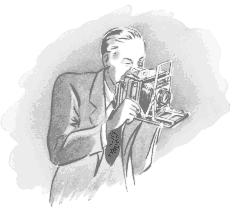| View previous topic :: View next topic |
| Author |
Message |
Nick
Joined: 16 Oct 2002
Posts: 494
|
 Posted: Sat Feb 14, 2004 8:25 pm Post subject: Posted: Sat Feb 14, 2004 8:25 pm Post subject: |
 |
|
| A while back one of the golden oldie TV stations here showed a documentary on Africa. In a few scenes they show a photographer with a MF TLR using flashbulbs. No problem so far. The thing is it was broad day light and he was photographing animals a fair distance away. Between the slow film he was likely using and the F/stops that MF is often used at those bulbs must have been really powerfull. I assume he was just using the bulbs to fill in the light but still he must have been at least 50 feet away. |
|
| Back to top |
|
 |
Henry
Joined: 09 May 2001
Posts: 1650
Location: Allentown, Pennsylvania
|
 Posted: Sun Feb 15, 2004 12:29 am Post subject: Posted: Sun Feb 15, 2004 12:29 am Post subject: |
 |
|
How powerful were flashbulbs?
Powerful enough to burn a hole in Les's polyester leisure suit. |
|
| Back to top |
|
 |
t.r.sanford
Joined: 10 Nov 2003
Posts: 812
Location: East Coast (Long Island)
|
 Posted: Sun Feb 15, 2004 3:10 am Post subject: Posted: Sun Feb 15, 2004 3:10 am Post subject: |
 |
|
Flashbulbs came in different strengths, of course. And films were not as slow as you might suppose. "Tri-X" had been rerated to 400 ASA by mid-decade, and Ansco "Super Hypan" was an ASA 500 material. Color films were slow, although Ansco started a speed race in the latter half of the '50s by introduceing "Super Anscochrome," a 100-speed transparency material that you could process yourself (they made a 16-fl.oz. kit available) -- if you did, you could extend development for exposure indices of 200 or 400.
A bayonet-base #5 or #25 put out a lot of light, making it difficult to use these bulbs with 400-speed films (not impossible; you used a higher shutter speed to cut off some of the illumination, and spent a good deal of time studying little charts, and doing long division in your head).
If memory serves, the guide number for a #5 in a 5-inch polished reflector with 400-speed film was something like 450 with the shutter set for 1/25 or 1/30. That would allow you to photograph an animal 50 feet away with flash alone, at f:9 (practically, f: . .
I'd guess there was ample light to fill in shadows at that distance, if you wanted a lighting ratio of 3:1 or greater, even if you were using a slower film. |
|
| Back to top |
|
 |
t.r.sanford
Joined: 10 Nov 2003
Posts: 812
Location: East Coast (Long Island)
|
 Posted: Sun Feb 15, 2004 4:47 am Post subject: Posted: Sun Feb 15, 2004 4:47 am Post subject: |
 |
|
This site induces sometimes disconcerting flashbacks...the technique nowadays called "fill flash" was popularized in the '50s as "synchro-sun" photography, and a good deal was written about it.
Speaking to the point of the power of flashbulbs, one accessory used for synchro-sun work was a plain white handkerchief. You calibrated this to determine how much light it absorbed when it was draped over the flash reflector, and again, when it was doubled and draped.
Unlike electronic flash, flashbulbs burned for rather a long period of time, even the medium-peak ones. Thus, exposure could be varied by changing the shutter speed. This gave you an additional control, but introduced something else you needed to figure into your calculations.
For head-and-shoulders portraits with the common #5 lamps, at least two thicknesses of handkerchief usually were required; and, of course, you generally were working at a fairly small aperture. |
|
| Back to top |
|
 |
|
|
You cannot post new topics in this forum
You cannot reply to topics in this forum
You cannot edit your posts in this forum
You cannot delete your posts in this forum
You cannot vote in polls in this forum
|
Powered by phpBB © 2001, 2005 phpBB Group
|


